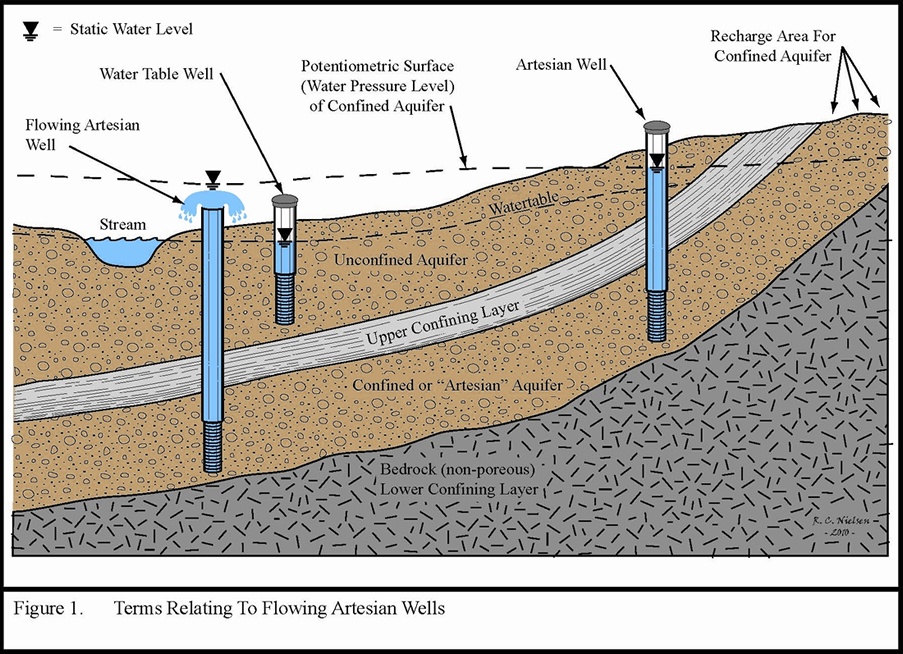Wells and Borings
- Request/Look-up Services
- Wells and Borings Home
- EPA Request: Nitrate
- CEUs
- Construction of Wells and Borings
- Contractors
- Fees
- Laws and Rules
- Licensing
- Minnesota Well Index
- Natural Disasters
- Permits
- Publications
- Resources
- Sealing of Wells and Borings
- Special Construction Areas
- Water Quality and Testing
- Water Information
- Well Disclosure
- Well Partners
Wells Program
Related Topics
- Accredited Laboratories/Well Water Testing
- Clean Water Fund
- Contaminants in Water
- Flooded Wells
- Pesticides
- Water and Health
Environmental Health Division
Flowing Well and Boring Special Construction Area
Flowing wells and borings are drilled holes that encounter an aquifer with sufficient natural pressure to force water above the ground surface, so that water will flow without pumping. Many wells in Minnesota are completed in confined aquifers with artesian conditions, meaning the water level in a water well rises above the top of the aquifer. If the water level rises above the land surface, it is known as a flowing artesian well.
Groundwater is water that is found beneath the surface of the earth and has saturated the pore spaces in unconsolidated geologic materials and bedrock and in fractures in bedrock. Groundwater is usually recharged from water which has percolated through the soil from precipitation on the land surface or from bodies of water. Groundwater can flow from points of higher elevation or pressure to points of lower elevation or pressure.
An aquifer is a geologic formation, either unconsolidated material like sand and gravel or permeable bedrock, which readily transmits water and is tapped for supplying groundwater to water-supply wells. In some cases, the groundwater may be under pressure because the aquifer is overlain by a confining layer, such as clay or shale. The confining layer retards the movement of groundwater and pressure can then build up within the aquifer. This condition can occur when the aquifer is recharged at a point of higher elevation than the location where the aquifer is under pressure. When a well (or boring) taps the underlying aquifer, the water level will rise in the well to a level above the top of the aquifer. This type of well is an artesian well. If the water level rises in the well to an elevation above the land surface, the well will actually flow. This well is referred to as a flowing artesian well. Please refer to Figure 1 for a visual depiction of the hydrogeologic conditions causing flowing artesian wells.
Click picture to enlarge.
Pressures and flows in flowing wells can vary from slightly more than atmospheric pressure and flows less than one gallon per minute to tens of pounds of pressure and flows of hundreds or thousands of gallons per minute. Flowing artesian wells can present major problems for casing completion and sealing of wells and borings. Uncontrolled flows can cause land erosion and land subsidence, pose safety concerns, damage drilling equipment and structures, and waste groundwater. Ungrouted casings can allow water to migrate up the outside of the casing, causing bore hole erosion and uncontrolled flows. Once a flow becomes uncontrolled, it is often difficult or impossible to regain control.
A well or boring with flows above the ground surface must be constructed to prevent erosion of the aquifer and the confining layer. Casing must be installed into the flowing aquifer to prevent water migrating up outside the casing. Minnesota Rules, part 4725.3450, detail the construction requirements for flowing wells and borings as follows:
- low flow, low pressure conditions (70 gallons per minute or less, ten pounds per square inch or less);
- high flow, high pressure conditions (greater than 70 gallons per minute, greater than ten pounds per square inch);
- flow control;
- overflow discharge.
The Minnesota Department of Health (MDH) has the authority to designate a Flowing Well and Boring Special Construction Area in a geographic area where high flow and high pressure conditions have been widely reported and flowing wells and borings have occurred. Contractors installing a well or boring within the designated area must follow the construction requirements in Minnesota Rules, part 4725.3450.
Flowing well and boring special construction areas
- Benedict Lake and Kabekona Lake - effective March 1, 1995 - includes portions of Sections 33 and 34, Township 143 North, Range 32 West (Lakeport Township) and of Sections 2, 3, 4, and 11 of Township142 North, Range 32 West (Steamboat River Township), Hubbard County.
Of interest
Flowing Wells in Minnesota (PDF)
Resource from Minnesota Department of Natural Resources
Questions
Well Management Section
651-201-4600 or 800-383-9808
health.wells@state.mn.us
Go to > top
